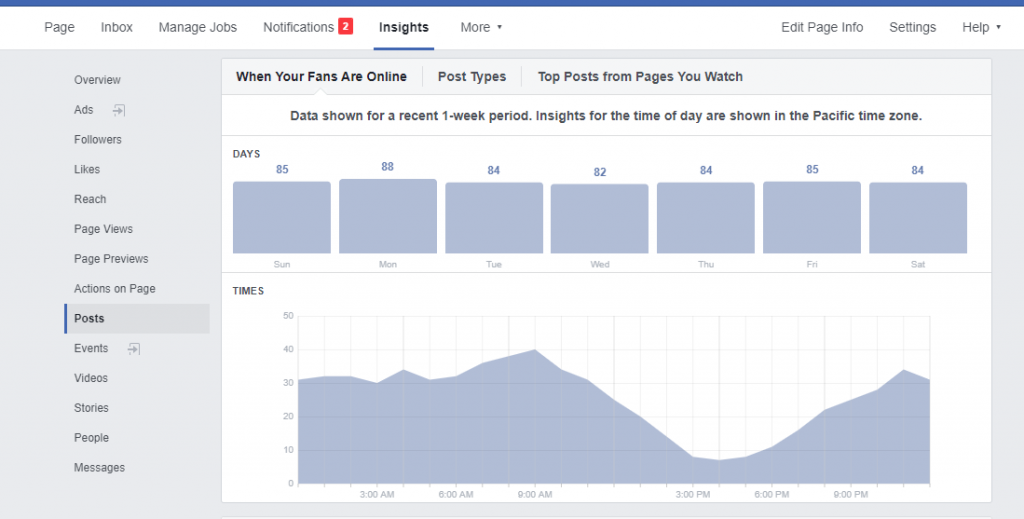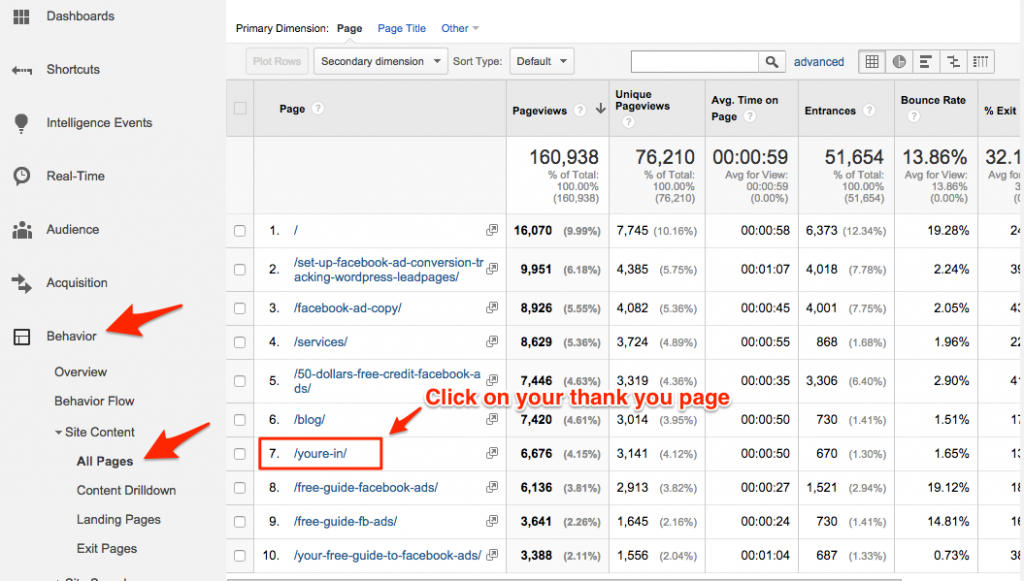Keep reading to find out 4 more tips to boost a post on Facebook.
4. The Right Time to Boost a Post on Facebook
Just same like there is the perfect time to post on Facebook (and other social networking platforms), there is a right time to boost a Facebook post. Data shows that Facebook posts published by B2C companies between 9-10 am, 12-1 pm, and 4-5 pm perform far better than posts published at other times of the day.
Does this mean you have to boost your Facebook post exactly at these times?
Not really.
You should check your page insights to find the time when your audiences are online and how your existing posts performed based on the time differences.
The page insights will give you information about days and time when your followers are online:
This will give you a good idea of your existing fans and it is assumed that your new followers will have similar behavior. So, boosting your Facebook post when most of your followers are online is a great starting point.
You can also take data about the engagement of already published posts based on day and time when they’re published. This will give you an idea of days and time when posts work well in terms of engagement.
If your goal of boosting a post is to send traffic to your website, use Google Analytics to find the best time to boost a Facebook post. Analyze the page in Google Analytics where you want to send traffic.
Let’s assume you are interested in generating leads and you’ll send traffic to a squeeze page to capture email addresses. Go to Google Analytics and look for the page that confirms a successful optin (normally a thank you page) in All Pages under Behavior:
Next, check the secondary dimension for hour. This is how it will look like:
There you go, you know the perfect time when people see the thank you page implying that the most appropriate time to boost a post to this squeeze page is 2 pm.
You can also find the great day of the week to boost a post by switching to the day of the week in the secondary dimension:
You need to schedule your boost post for the exact day and time to make it effective.
5. Set Reasonable Duration
The duration of the boost post on Facebook plays an important role in making it successful. It is recommended not to boost a post for more than a week. When your audience is narrow, the post will be shown to the same people several times. This can backfire. Your audience might get irritated from your ad.
So, set the duration to a week.
After setting the duration of the boost for a week, monitor the performance of your ad multiple times a day. If the post’s performance declines, pause the ad. Don’t let it run. Go to Ads Manager to verify performance and look at the following metrics:
- Frequency
- Unique link clicks
- Reach
- Impression
Frequency is the most essential metric here that refers to the average number of times each person saw your ad. The frequency should be low ideally. However, it depends on the kind of post you are boosting.
If you are boosting an informative post that you want people to read on your blog, a frequency of 2 or above won’t be a good sign. If a person who didn’t read your post the first time isn’t likely to read it the next time either.
However, if you are sending traffic to a squeeze page (or a landing page), a high frequency won’t harm because you are boosting a marketing page that people usually resist clicking. Repetition, in this case, won’t do much harm.
Similarly, if your purpose is to boost brand awareness, high frequency is ideal. Frequency isn’t the only metric that you should be concerned about. Reach and impressions are also critical in determining the actual ad duration.
When reach and impressions slow down, pause your boosted post as it is an indication that your ad isn’t reaching enough people.
So, here is what you should do to save your money from burning boosted post budget:
- Set ad duration for a week
- Monitor performance regularly
- Pause ad when it stops performing (or numbers stall)
6. Don’t Auto Boost
Facebook offers automatically boosted post feature which is a monthly advertising plan for boosting posts. A lot of social media management tools also offer this feature to automatically boost Facebook posts (e.g. Hootsuite).
Don’t use this feature. Period.
It might lead to boosting posts that aren’t strategically important for your business. You don’t have to boost every high-performing post. That’s not how marketing works.
You need to utilize your marketing budget carefully by investing it in campaigns that are expected to yield the highest ROI. We have already covered the importance of setting a clear goal for your boosted post campaign and selecting the right post.
Don’t let any tool ruin your marketing budget by boosting irrelevant posts.
7. Experiment and Test
The best approach to running a successful and effective boost post on Facebook is to test and experiment. See what works best for your company, why it works, and how you can improve the performance of your boosted posts.
Don’t hesitate to experiment.
Even if a boosted post fails, don’t panic. Learn from the mistakes. See what went wrong and fix it. That’s how you’ll make your boosted posts successful.
You have the information, data and all the resources available in Ads Manager. Make the best use of it.
Conclusion
Boosting a post on Facebook is one of the simplest things to do. Anyone can do it. However, making it run successfully and utilizing your budget effectively is the real big challenge. The tips and techniques covered above will help you solve this issue.
When done right, a Facebook boosted post can increase engagement, improve brand awareness, and send heaps of targeted traffic to your website. Once you start seeing results, you’ll fall in love with the boost post. Let’s get started today and make your boosted posts successful with these 7 tips.








